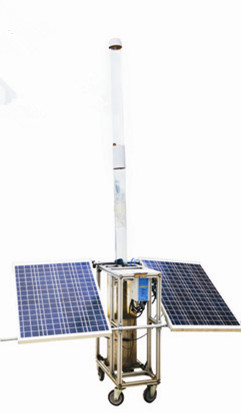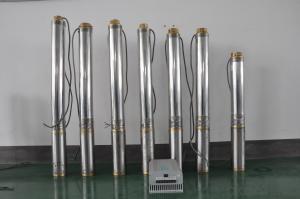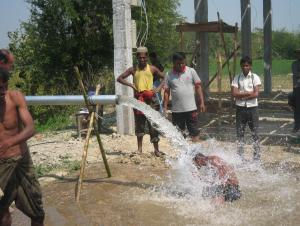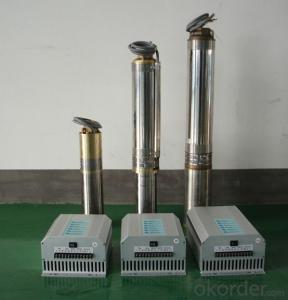Solar Water Pump 3DS-4
- Loading Port:
- China Main Port
- Payment Terms:
- TT OR LC
- Min Order Qty:
- -
- Supply Capability:
- 300 sets set/month
OKorder Service Pledge
OKorder Financial Service
You Might Also Like
Product description:
Product: Solar water pump
Model:3DS-4

Appilication:
submersible pump
for deep well near a house
for drinking water of one family (3-4 people)
for watering a small garden
Product specification:
flow rate:300 liter/ hour, 2m3/day.
lift: 10m-100m
pump diameter: 94mm
well diameter more than 102mm
with BLDC motor, motor power:360W
but only need solar power:100W, our pump can save more than 50% solar panel power.
Material:
Pump inside: stainless steel and wearable nylon,it enables our solar pump to have 10 years sevice life.
Motor length:20cm,70% shorter than other motors. So that you can pump 70% more water by our solar pump.
Certification:
3 International patent
ISO9001
CE
Warranty:2 years
- Q:Can a solar pump be used for water supply in off-grid scientific expeditions?
- Yes, a solar pump can certainly be used for water supply in off-grid scientific expeditions. Solar pumps are an excellent choice for remote areas where access to grid electricity is limited or non-existent. They utilize solar energy to power the pump, eliminating the need for fuel or electricity from the grid. Solar pumps are highly efficient and reliable, making them well-suited for scientific expeditions that require a consistent and reliable water supply. They can be used to extract water from various sources such as wells, rivers, or lakes, providing a sustainable and renewable solution for water needs. Additionally, solar pumps are easy to install and require minimal maintenance, which is crucial in remote locations where technical support may be limited. They are also environmentally friendly, as they produce no greenhouse gas emissions and have a minimal carbon footprint. Overall, a solar pump is a practical and sustainable choice for water supply in off-grid scientific expeditions. It offers a reliable and efficient solution while reducing the dependence on traditional energy sources, making it an ideal choice for researchers and scientists working in remote areas.
- Q:How does a solar pump help in reducing the risk of food insecurity?
- A solar pump helps in reducing the risk of food insecurity by providing a reliable and sustainable source of water for irrigation. With access to water, farmers can cultivate crops throughout the year, even in areas with limited rainfall. This leads to increased agricultural productivity, higher crop yields, and reduced dependence on rain-fed agriculture. By ensuring a consistent water supply, solar pumps contribute to improved food production, lower vulnerability to droughts, and ultimately, a decreased risk of food insecurity in communities.
- Q:Can a solar pump be used for desalination processes?
- Yes, a solar pump can be used for desalination processes. A solar pump utilizes solar energy to power the pump, which can be used to extract water from sources such as wells, rivers, or oceans. In the case of desalination, the solar pump would be employed to draw seawater and transport it to the desalination plant. Desalination is the process of removing salt and other impurities from seawater to make it suitable for human consumption or irrigation purposes. Solar pumps are an ideal choice for desalination processes due to their use of renewable energy, making them cost-effective and environmentally friendly. Solar pumps can be utilized in various desalination techniques such as reverse osmosis (RO) or multi-stage flash (MSF) distillation. In the RO process, the solar pump is used to pressurize seawater through a semi-permeable membrane, separating the salt and other impurities from the water. In MSF distillation, the solar pump is employed to transport seawater to the heat exchangers where it is heated and evaporated, leaving behind the salt and other impurities. The use of solar pumps for desalination processes has several advantages. Firstly, solar energy is abundant and free, so it significantly reduces operational costs compared to traditional fuel-powered pumps. Solar pumps also require minimal maintenance and have a long lifespan, making them a reliable and sustainable option for desalination plants. Additionally, using solar pumps for desalination processes reduces reliance on fossil fuels, contributing to a reduction in greenhouse gas emissions and overall environmental impact. This aligns with the global efforts towards clean energy and sustainability. In conclusion, a solar pump can indeed be used for desalination processes, offering a cost-effective and environmentally friendly solution for extracting and treating seawater to make it suitable for various applications.
- Q:Can a solar pump be used for fountains and decorative water features?
- Yes, a solar pump can be used for fountains and decorative water features. Solar pumps are designed to operate using energy from the sun, making them an eco-friendly and cost-effective option for powering water features. These pumps typically consist of a solar panel, which absorbs sunlight and converts it into electricity, and a pump that circulates the water. They are available in various sizes and capacities to suit different fountain and water feature sizes. Solar pumps also often come with battery backup systems, allowing them to work even during cloudy days or at night. Additionally, they are easy to install and require minimal maintenance, making them a popular choice for both residential and commercial applications.
- Q:Can solar pumps be used for water supply in remote agricultural or farming communities?
- Yes, solar pumps can be used for water supply in remote agricultural or farming communities. They are a reliable and sustainable solution as they use solar energy to power the pumps, eliminating the need for electricity or fuel. This makes them suitable for areas with limited or no access to the power grid. Solar pumps are also cost-effective in the long run, as they require minimal maintenance and have no operational costs. Additionally, they can provide a consistent and sufficient water supply, crucial for irrigation and livestock needs in remote farming communities.
- Q:Can a solar pump be used for water supply in refugee camps or emergency situations?
- Yes, a solar pump can definitely be used for water supply in refugee camps or emergency situations. Solar pumps are powered by sunlight, making them highly suitable for areas with limited access to electricity. They can efficiently extract water from wells, boreholes, or other water sources, providing a reliable and sustainable water supply for the displaced populations in refugee camps or emergency situations. Additionally, solar pumps are low-maintenance, environmentally friendly, and cost-effective, making them an ideal solution in such scenarios.
- Q:How does the performance of a solar pump vary with different pumping distances?
- The performance of a solar pump can vary with different pumping distances. As the pumping distance increases, the performance of the solar pump may decrease due to various factors. One of the main factors affecting the performance of a solar pump with different pumping distances is the head height or vertical distance the water needs to be pumped. The higher the head height, the more energy the pump requires to lift the water, and this can result in reduced performance. Solar pumps have a maximum head height they can reach, and exceeding this limit may result in decreased flow rate and efficiency. Additionally, the distance between the pump and the water source can also impact the performance. As the pumping distance increases, friction losses in the pipes can occur, leading to a drop in performance. The longer the distance, the more significant the friction losses become, resulting in reduced flow rate and efficiency. Furthermore, the size and capacity of the solar pump also play a role in performance variation. Different pumps have different power ratings and flow rates. When choosing a solar pump for a specific pumping distance, it is crucial to select a pump that can handle the required flow rate and head height efficiently. It is important to note that the performance of a solar pump can also be influenced by other factors such as the quality and condition of the solar panels, the amount of sunlight available, and the overall system design. Therefore, it is recommended to consult with a solar pump expert or supplier to determine the most suitable pump for a specific pumping distance to ensure optimal performance.
- Q:Is it possible to store excess solar energy generated by the pump?
- Excess solar energy generated by the pump can indeed be stored. The use of batteries is a common method for storing this surplus energy. Throughout the day, these batteries gather and retain the excess energy, which can then be discharged during periods when the pump fails to generate sufficient energy, such as at night or on cloudy days. Furthermore, alternative energy storage technologies, including thermal energy storage and hydrogen fuel cells, can also be employed to stockpile excess solar energy for subsequent use by the pump. These storage solutions enable a more effective and dependable utilization of solar energy, guaranteeing the pump's operation even in the absence of direct sunlight.
- Q:What are the different applications of solar pumps?
- Solar pumps have a wide range of applications across various sectors. Some of the different applications of solar pumps include: 1. Agriculture: Solar pumps are extensively used in agricultural fields for irrigation purposes. They can efficiently transport water from wells, rivers, or other water sources to irrigate crops, ensuring a consistent water supply for farming activities. 2. Livestock watering: Solar pumps are ideal for providing water to livestock in remote areas where access to electricity may be limited. They can be used to pump water from wells or reservoirs to troughs, ensuring animals have a constant supply of fresh water. 3. Drinking water supply: In rural or off-grid communities without access to reliable electricity, solar pumps can be used to provide clean drinking water. They can pump water from underground sources or rivers and transport it to a storage tank, where it can be treated and distributed to households. 4. Fountain and decorative displays: Solar pumps are commonly employed to power fountains and decorative water displays in gardens, parks, or public spaces. These pumps harness sunlight to circulate water, creating beautiful and environmentally-friendly water features. 5. Water circulation and aeration: Solar pumps can be used to circulate water in ponds, lakes, or reservoirs, enhancing water quality and preventing stagnation. They can also be employed for aeration purposes, promoting the growth of healthy aquatic life. 6. Drip irrigation systems: Solar pumps are suitable for drip irrigation systems, which deliver water directly to the base of plants, minimizing water wastage. These systems are particularly useful in arid or water-scarce regions, where every drop of water is valuable. 7. Swimming pool filtration: Solar pumps can be utilized to power the filtration systems of swimming pools. They can efficiently circulate water through filters, removing debris and maintaining water clarity, all while reducing energy consumption. 8. Water supply for remote locations: Solar pumps are commonly used to provide water supply in remote locations, such as mountainous areas or islands, where connecting to the main power grid is challenging. They offer an independent and sustainable solution for accessing water in these isolated regions. In conclusion, solar pumps have a diverse range of applications, from agricultural irrigation and livestock watering to providing clean drinking water and powering decorative displays. Their versatility and ability to operate off-grid make them an excellent choice for various water pumping needs.
- Q:Can a solar pump system be expanded or upgraded in the future?
- Yes, a solar pump system can be expanded or upgraded in the future. Solar pump systems are designed to be modular and scalable, allowing for easy expansion as per the user's needs. Additional solar panels can be added to increase the system's power output, allowing for more pumps or larger pumps to be operated. Similarly, the capacity of the battery bank can be increased to store excess power generated during the day for use during the night or during periods of low sunlight. Additionally, the control system and monitoring equipment can be upgraded to incorporate more advanced features, such as remote monitoring and automation. Overall, the flexibility and modularity of solar pump systems make them highly expandable and upgradeable, ensuring that they can adapt to changing requirements and technological advancements in the future.
1. Manufacturer Overview |
|
|---|---|
| Location | |
| Year Established | |
| Annual Output Value | |
| Main Markets | |
| Company Certifications | |
2. Manufacturer Certificates |
|
|---|---|
| a) Certification Name | |
| Range | |
| Reference | |
| Validity Period | |
3. Manufacturer Capability |
|
|---|---|
| a)Trade Capacity | |
| Nearest Port | |
| Export Percentage | |
| No.of Employees in Trade Department | |
| Language Spoken: | |
| b)Factory Information | |
| Factory Size: | |
| No. of Production Lines | |
| Contract Manufacturing | |
| Product Price Range | |
Send your message to us
Solar Water Pump 3DS-4
- Loading Port:
- China Main Port
- Payment Terms:
- TT OR LC
- Min Order Qty:
- -
- Supply Capability:
- 300 sets set/month
OKorder Service Pledge
OKorder Financial Service
Similar products
New products
Hot products
Related keywords



























